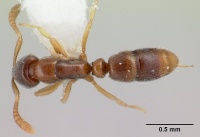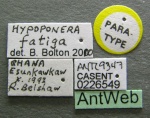Hypoponera fatiga
| Hypoponera fatiga | |
|---|---|

| |
| Scientific classification | |
| Kingdom: | Animalia |
| Phylum: | Arthropoda |
| Class: | Insecta |
| Order: | Hymenoptera |
| Family: | Formicidae |
| Subfamily: | Ponerinae |
| Tribe: | Ponerini |
| Genus: | Hypoponera |
| Species: | H. fatiga |
| Binomial name | |
| Hypoponera fatiga Bolton & Fisher, 2011 | |
This small species is currently known from only a few forest leaf litter samples but appears to be very widely distributed.
Identification
A member of the abeillei group.
Keys including this Species
Distribution
Latitudinal Distribution Pattern
Latitudinal Range: 7.9° to -5.732599°.
| North Temperate |
North Subtropical |
Tropical | South Subtropical |
South Temperate |
- Source: AntMaps
Distribution based on Regional Taxon Lists
Afrotropical Region: Central African Republic, Ghana (type locality), Kenya, Uganda, United Republic of Tanzania.
Distribution based on AntMaps
Distribution based on AntWeb specimens
Check data from AntWeb
Countries Occupied
| Number of countries occupied by this species based on AntWiki Regional Taxon Lists. In general, fewer countries occupied indicates a narrower range, while more countries indicates a more widespread species. |

|
Estimated Abundance
| Relative abundance based on number of AntMaps records per species (this species within the purple bar). Fewer records (to the left) indicates a less abundant/encountered species while more records (to the right) indicates more abundant/encountered species. |

|
Biology
Castes
Nomenclature
The following information is derived from Barry Bolton's Online Catalogue of the Ants of the World.
- fatiga. Hypoponera fatiga Bolton & Fisher, 2011: 52, figs. 43-45 (w.q.) GHANA.
Unless otherwise noted the text for the remainder of this section is reported from the publication that includes the original description.
The various populations are remarkably similar and show only slight differences in the ranges of dimensions, which at present are not considered as significant at species-rank. However, the Kenyan samples tend to have a petiole node that is somewhat more tapered dorsally, though the taxonomic significance of this is not currently apparent. The acquisition of samples from the vast territories that lie between these populations is essential, so that the situation can be assessed more accurately. In itself, the discovery of closely related populations as far apart as Ghana and Kenya, is not surprising, because the Kakamega Forest is the easternmost extension of the vast west and central African forest zone. That the species spans the entire zone is hinted at by the presence of a single specimen from Central African Republic. Critical measurements and indices of the main populations, for comparative purposes, are as follows.
Ghana workers (BMNH, CASC, BBRC). Measurements: HL 0.47–0.50, HW 0.36–0.38, HS 0.415–0.440, SL 0.28–0.32, PrW 0.28–0.30, PeNL 0.12–0.13, PeH 0.28–0.31, PeNW 0.20–0.22, PeS 0.200–0.220 (13 measured). Indices: CI 75–77, SI 78–86, PeNI 70–78, LPeI 41–43, DPeI 162–180.
Uganda workers ((KUIC). Measurements: HL 0.51–0.53, HW 0.38–0.40, HS 0.435–0.450, SL 0.31–0.33, PrW 0.30–0.31, PeNL 0.12, PeH 0.29–0.31, PeNW 0.20–0.21, PeS 0.203–0.213 (4 measured). Indices: CI 73–75, SI 82–83, PeNI 67–69, LPeI 39–41, DPeI 165–170.
Kenya workers (ZFMK). Measurements: HL 0.50–0.52, HW 0.38–0.40, HS 0.445–0.450, SL 0.33–0.34, PrW 0.28–0.30, PeNL 0.12–0.14, PeH 0.30–0.32, PeNW 0.20–0.22, PeS 0.210–0.227 (8 measured). Indices: CI 75–80, SI 84–87, PeNI 69–76, LPeI 39–44, DPeI 155–170.
Tanzania workers (KUIC). Measurements: HL 0.46–0.50, HW 0.36–0.38, HS 0.410–0.440, SL 0.28–0.31, PrW 0.27–0.29, PeNL 0.12, PeH 0.27–0.30, PeNW 0.18–0.20, PeS 0.195–0.207 (4 measured). Indices: CI 75–78, SI 78–83, PeNI 67–74, LPeI 40–44, DPeI 155–167. See also the notes under Hypoponera defessa and Hypoponera juxta.
Description
Worker
(holotype in parentheses). Measurements: HL 0.46–0.53 (0.49), HW 0.36–0.40 (0.38), HS 0.410–0.450 (0.435), SL 0.28–0.34 (0.32), PrW 0.26–0.31 (0.29), WL 0.58–0.68 (0.64), HFL 0.28–0.34 (0.32), PeNL 0.12–0.14 (0.13), PeH 0.27–0.32 (0.30), PeNW 0.18–0.22 (0.22), PeS 0.195–0.227 (0.217) (30 measured). Indices: CI 73–80 (77), SI 78–87 (84), PeNI 67–78 (76), LPeI 39–44 (43), DPeI 155–180 (169).
Eyes absent. Median portion of clypeus with a raised median longitudinal ridge or crest. Apex of scape, when laid straight back from its insertion, distinctly fails to reach the midpoint of the posterior margin in full-face view; distance from apex of scape to midpoint ca 0.20 × SL, greater than the apical width of the scape; SL/HL 0.60–0.67. Reticulate-punctate sculpture on cephalic dorsum fine and dense, the punctures crowded, small and sharply defined. Lateroventral areas of head almost smooth, with widely separated, minute, superficial punctulae. Punctate sculpture on dorsum of pronotum about the same as on lateroventral surface of head. Metanotal groove entirely absent from dorsum of mesosoma. Sides of propodeal declivity weakly marginate. Petiole node in dorsal view transverse, the anterior and lateral surfaces distinctly convex, but not thickly D-shaped. Petiole node in profile slender and of moderate height, with the sides weakly convergent from just above tubercle to apex; dorsum very shallowly convex. Posterior surface of petiole node without radiating cuticular ribs above the peduncle. Subpetiolar process with a blunt ventral angle. Base of cinctus of second gastral tergite with short, fine, crowded cross-ribs. Disc of second gastral tergite microreticulate to superficially reticulate-punctate; without sharply incised widely separated punctures. Maximum width of first gastral tergite in dorsal view is less than the width of the second tergite at its midlength. Midline length of second gastral posttergite, from posterior margin of cinctus to apex, is slightly less than the maximum width of the segment. Suberect to erect setae on dorsum of first gastral tergite sparse and short, stubbly. Full adult colour light brown to brown.
Type Material
Holotype worker (top specimen of two on pin), Ghana: Esunkawkaw, x.1992 (R. Belshaw) (The Natural History Museum).
Paratypes. 22 workers and 3 dealate queens, with same data as holotype (BMNH, California Academy of Sciences, Barry Bolton Reference Collection).
References
References based on Global Ant Biodiversity Informatics
- Bolton B. and B. L. Fisher. 2011. Taxonomy of Afrotropical and West Palaearctic ants of the ponerine genus Hypoponera Santschi (Hymenoptera: Formicidae). Zootaxa 2843: 1-118
- Bolton, B., and B. L. Fisher. "Taxonomy of Afrotropical and West Palaearctic ants of the ponerine genus Hypoponera Santschi (Hymenoptera: Formicidae)." Zootaxa 2843 (2012): 1-118.
- Ross S. R. P. J., F. Hita Garcia, G. Fischer, and M. K. Peters. 2018. Selective logging intensity in an East African rain forest predicts reductions in ant diversity. Biotropica 1-11.


